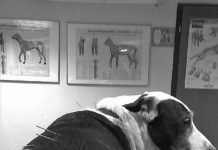Earlier Diagnosis of Addisons on the Horizon
Addisons disease is already far along by the time a dogs owner notices something is wrong, says Tufts veterinarian Orla Mahony, MVB. At diagnosis, all Addisonian dogs have already lost more than 90 percent of their adrenal gland function. Thats why by the time its picked up, a dog needs replacement hormones for the rest of his life.
All About Complete Blood Counts for Dogs
Your dog is not herself. Shes tired more than usual, perhaps kind of weak and mopey, and has lost much of her appetite. Does she have an infection? Might she be anemic? Could it be something more serious? Maybe shes simply about to undergo an operation and the vet wants to check her overall state to see if the standard dose of anesthesia will need to be adjusted. Or her health is perfectly fine but…
Veterinarians Getting Behind Acupuncture
At two and a half years old, Scout was having unexplained seizures. They were very difficult to control, says his owner, Deborah Prevratil. He was on standard phenobarbital and other medicines and still, we averaged anywhere from four seizures a day down to one. But after working with a veterinarian schooled in acupuncture, Scout went down to one seizure every two weeks. Right now he has been seizure-free for more than three months, says.
Three U.S. Courses for Veterinary Acupuncture
There are three ways a veterinarian can receive certification for using acupuncture to treat dogs and other animals, and while theres overlap, the approaches differ to some degree. Note that there is no board certification in acupuncture recognized by the American Veterinary Medical Association. These certifications are considerably less rigorous than those for, say, anesthesia or internal medicine.
Dear Doctor – Choosing a kennel cough vaccine
Q I own a two-year-old Labrador retriever who was recently due for his bordetella booster. Last year he was given the injectable vaccine.
Common Foot Problems in Dogs
The reason that evidence of allergies is so often found on a dogs feet is that theres not much hair on and between the toes. Hair acts as a barrier, Dr. Lam says, so absorption of environmental allergens like pollen, dust, mites, or mold through the skin is easy if the hair coat is sparse. Its true for any area on a dogs body where the hair is relatively thin, she says - the ears, under the arms, and in the groin area as well.
Is My Dog Too Thin?
One reason people may perceive perfectly healthy dogs to be underweight when they arent is that the nations dogs have been experiencing an obesity crisis paralleling that of their owners, causing too heavy to become the new normal and ideal weight to become too thin. So many dogs are now overweight that it doesnt stand out as much anymore. What stands out are dogs on the thin side.
When Mother Dogs Need Birth Assistance
Easy was not having an easy time of it. The German shepherd, pregnant with nine puppies as confirmed by radiographs, was in hard labor with really heavy contractions, says her owner Cindy Miller - but none of the contractions were adequate to deliver her babies. It was getting to the point at which both the mother and her pups would be in serious distress. …
Tail tales
Kato, a one-year-old Siberian husky, had been missing for three days. His owner was frantic. Finally Kato returned home with a ghastly wound. His tail had been what veterinarians call de-gloved - the skin was stripped away - and you could see bone and muscle hanging out. In addition, one of the tail bones had been fractured - it showed on an x-ray. …
When the Tail Goes Limp
It has been called cold tail, dead tail, and limber tail, but all three terms mean the same thing -the dogs tail hangs limp from the base. The cause of the drooping tail, which comes on suddenly rather than gradually, is thought by many to be muscle injury brought on by overexertion. Its the coccygeal muscles near the tails base that are believed to sustain the damage leading to the drooping, although there is some…
Dry Eye: A Common Canine Problem
Dogs, like humans, produce tears that form an essential layer - the tear film - which covers the transparent cornea at the front of the eye. The tear film provides lubrication for the outer surface of the cornea. However, lubrication is not its only function. The tear film helps nourish and protect the cornea, and last but not least, has important optical properties. The film is so important to vision that it is actually…













